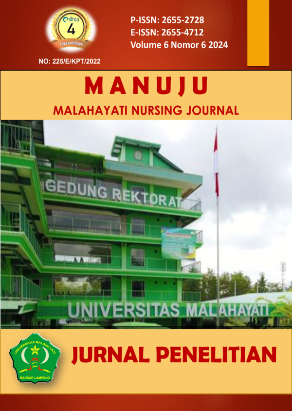- Nama Jurnal: Manuju : Malahayati Nursing Journal
- Initials: Manuju
- Online ISSN: 2655-4712
- Print ISSN: 2655-2728
- Editor in Chief: Dr. Aprina, S.Kp., M.Kes
- Frekuensi: Setiap Bulan
- Publisher: Universitas Malahayati Lampung
MANUJU : Malahayati Nursing Journal merupakan jurnal yang memiliki fokus utama pada hasil penelitian dan ilmu-ilmu di bidang kesehatan yang dikembangkan dengan pendekatan interdispliner dan multidisiplin. Proses penerimaan naskah selalu terbuka setiap waktu, naskah yang sudah disubmit oleh penulis akan direview oleh reviewer yang memiliki track record jurnal internasional bereputasi.
MANUJU : Malahayati Nursing Journal telah menggunakan Open Journal System sejak pertama kali terbit pada tahun 2019 dimana penulis, editor, dan reviewer bisa memantau proses naskah secara online.
MANUJU: Malahayati Nursing Journal Terakreditasi SINTA 4 No: 225/E/KPT/2022.
MANUJU: Malahayati Nursing Journal menerbitkan setiap bulan sejak 2022.

MANUJU: Malahayati Nursing Journal mempriortitaskan artikel berbahasa Inggris untuk diterima. Artikel akan direview oleh dua reviewer, proses review akan dilakukan setelah ada bukti registrasi (pembayaran) yang harus dikonfirmasikan bukti bayar ke WA 08117916669
Terindeks oleh:
Informasi
PERUBAHAN PENERBITAN |
|
Salam penulis MANUJU: Malahayati Nursing Journal Sehubungan dengan peningkatan minat tulis Dosen dan Mahasiswa pada jurnal MANUJU: Malahayati Nursing Journal, sehingga kami pengelola jurnal mengambil kebijakan yaitu mulai tahun 2022 akan menerbitkan jurnal setiap bulan. sekian info dari pengelola
Editor in Chief Dr. M. Arifki Zainaro, S Kep., Ns., M. Kep |
|
| Dikirimkan: 2022-01-20 | Lebih Lanjut... |
| Lebih banyak informasi... |
Vol 7, No 7 (2025): Volume 7 Nomor 7 (2025)
Jurnal ini berisikan hasil penelitian ilmiah yang dilakukan oleh Dosen dan Mahasiswa Perguruan Tinggi yang ada di seluruh Indonesia. Silahkan yang ingin cover depan, dewan redaksi, daftar isi dan cover belakang Volume 7 Nomor 7 (2025). Download disini.



 Panduan Penulisan
Panduan Penulisan
















